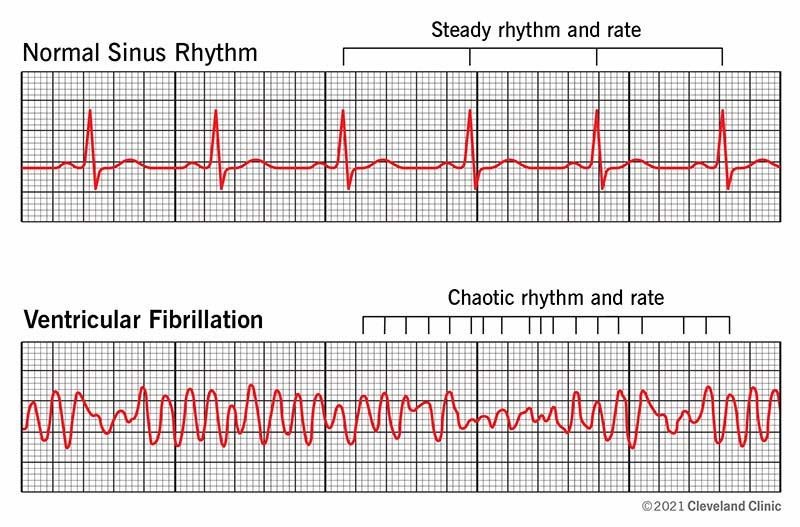
Contents
- 1 Atrial Fibrillation (AFib) vs. Ventricular Fibrillation (VFib)
- 1.0.1 What are the main differences between AFib and VFib?
- 1.0.2 What are the main similarities between these two heart conditions?
- 1.0.3 What are AFib and VFib, and how do they affect the heart?
- 1.0.4 Is AFib or VFib more serious?
- 1.0.5 Differences in how AFib and VFib feel to a person (signs and symptoms)
- 1.0.6 What causes these two heart diseases?
- 1.0.7 How do the EKG patterns differ for AFib and VFib?
- 1.0.8 Treatment for AFib and VFib
- 1.0.9 From
Atrial Fibrillation (AFib) vs. Ventricular Fibrillation (VFib)
Atrial fibrillation and ventricular fibrillation are heart conditions that include the term “fibrillation.” In relation to the heart, "fibrillation" refers to a rapid irregular contraction of the heart’s muscle fibers.
What are the main differences between AFib and VFib?
Atrial fibrillation or AFib, and ventricular fibrillation, or VFib, are both abnormal heart rhythms called arrhythmia.
One main difference is that ventricular fibrillation is life-threatening without immediate treatment, while atrial fibrillation is not immediately life-threatening, but can cause dangerous problems with heart function if not effectively treated.
- AFib produces irregular electrical signals in the upper chambers of the heart muscle called the atria (and may include the AV node), causing the heart’s atria to beat irregularly and usually faster than normal. AFib is not an immediately life-threatening abnormal heartbeat (arrhythmia).
- VFib produces irregular electrical signals in the lower chamber heart muscles (ventricles) that are so chaotic that the heart muscles can’t effectively pump blood. This type of heart condition is life-threatening and requires immediate treatment to prevent death.
What are the main similarities between these two heart conditions?
Both types of heart disease are abnormal heart rhythms. AFib and VFib can be detected by ECG and CPR defibrillators, machines that identify arrhythmias and can deliver shocks or electrical impulses to the heart to treat life-threatening arrhythmias like VFib.
What are AFib and VFib, and how do they affect the heart?
To understand AFib and VFib, you need to know how the heart normally works. The heart has four chambers: two uppers called the atria and two lowers called the ventricles.
- The impulse is first generated at the sinoatrial node (SA node), causing the right atrium to contract and send blood to the right ventricle.
- The right ventricle then sends blood to the lungs to get rid of carbon dioxide (CO2) and pick up oxygen (O2).
- The lungs return fresh oxygenated blood to the left atrium, which contracts to fill the left ventricle.
- The left ventricle contracts and generates the pulse, sending fresh oxygenated blood under pressure (blood pressure) to the body’s organs.
- Each heartbeat repeats this process, normally producing a consistent electrical signal. An abnormal heart rhythm occurs when the electrical signal is irregular.
AFib and VFib are both types of arrhythmias.
AFib is a type of arrhythmia called supraventricular tachycardia, meaning the problem occurs above the ventricles. In AFib, abnormal heart rhythms are due to irregular electrical activity in the atria, mainly the right atrium. It usually results in a fast and irregular heartbeat.
In contrast, VFib occurs when the electrical signal is chaotic within the ventricular muscle tissue and results in no effective heartbeat, blood pressure, or pulse. If VFib continues without immediate treatment, it can cause sudden cardiac death.
Is AFib or VFib more serious?
VFib is more serious. If ventricular fibrillation isn’t treated immediately, the patient will experience "sudden death" or "cardiac arrest."
Differences in how AFib and VFib feel to a person (signs and symptoms)
Atrial fibrillation signs and symptoms
A person with AFib may have no symptoms, but in general, they may notice irregular and rapid heartbeat. Other symptoms may include:
- Fatigue (especially during exercise)
- A fluttering or thumping sensation in the chest
- Weakness
- Dizziness
- Shortness of breath
- Anxiety
- Feeling like you are going to faint
- Confusion
- Chest discomfort or pain (seek emergency medical attention if you experience this symptom)
Ventricular fibrillation symptoms
In contrast, ventricular fibrillation (VFib) has very short-lived signs and symptoms.
- Sudden collapse
- Fainting with no response to stimulation (loss of consciousness)
- No or weak, erratic pulse
- Death if not immediately treated
About an hour before a person suddenly collapses due to ventricular fibrillation, they may experience these signs and symptoms:
- Dizziness
- Nausea
- Shortness of breath
- Chest pain and/or rapid heartbeat
What causes these two heart diseases?
Many underlying medical problems may contribute to the development of AFib and/or VFib.
Some common causes of both heart conditions include:
- Heart or cardiovascular disease
- Cardiomyopathy
- Drugs
- Alcohol consumption
- High cholesterol levels
- Increasing age
- A diet containing high levels of animal fat (meat)
- Severe infections
- High blood pressure
- Metabolic imbalances
- Stimulants (medications, caffeine, nicotine)
- Stress
How do the EKG patterns differ for AFib and VFib?
The EKG patterns in most cases are diagnostic for AFib and/or VFib because of the characteristic waveforms each produces.
Normal ECG wave strip pattern
Atrial fibrillation ECG
AFib shows irregular P wave patterns (the small “spike” just before the QRS or big spike pattern), indicating irregular atrial contractions interrupted by QRS patterns (heartbeats or effective ventricular cardiac blood pumping).
ECG (electrocardiogram or EKG) of VFib shows only fast irregular electrical tracings with no tracings showing a QRS (the large “spike” pattern on a normal ECG) indicating a heartbeat (ventricular contraction).
By clicking "Submit," I agree to the MedicineNet Terms and Conditions and Privacy Policy. I also agree to receive emails from MedicineNet and I understand that I may opt out of MedicineNet subscriptions at any time.
Treatment for AFib and VFib
Atrial fibrillation may automatically revert to normal sinus rhythm and require no treatment in some cases. Many people with AFib can be treated with heart rate controlling or rhythm-controlling medications. Additionally, some people may respond well to electrical cardioversion, which involves giving the heart an electrical shock to reset its normal electric pattern. Ablation techniques can also be used to destroy malfunctioning heart tissue responsible for abnormal atrial electrical activity.
Ventricular fibrillation is an emergency heart condition that requires immediate therapy. VFib can be treated with an electrical shock to the heart using a defibrillator. If a defibrillator is not immediately available, CPR with chest compressions is used to keep the person alive until a defibrillator shock can terminate VFib. This allows the heart to produce an effective electrical current and return to normal cardiac rhythm. Ventricular fibrillation may be a sign of a dying heart and may be difficult to treat in some cases. Defibrillation may not work, and the patient may die due to cardiac arrest.
From
Heart Health Resources
- AFib: Could You Be Living Better?
- HCM: Is It All In The Family?


